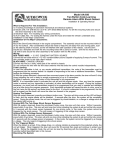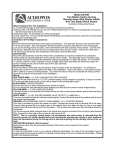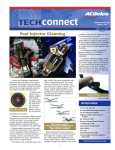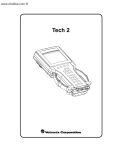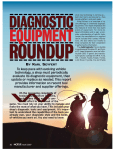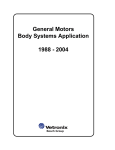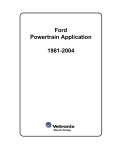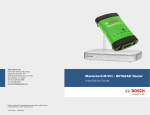Download Subaru On-Board Diagnostic Systems
Transcript
Subaru On-Board Diagnostic Systems E arly OBD (on-board diagnostic) systems, now referred to as OBD-I, could turn on a malfunction indicator light (MIL) and store hard fault codes when an emission-related system or component fault was detected. A hard fault is defined as a fault that is present while the vehicle computer is monitoring a particular circuit or device (meaning the fault is not intermittent). If the fault went away, the MIL was turned OFF by the computer. The Environmental Protection Agency (EPA) now has regulations in place that establish requirements for on-board diagnostic (OBD-II) systems on light-duty vehicles and light-duty trucks. The purpose of the OBD-II system is to ensure proper emission control system operation for the vehicle’s lifetime by monitoring emission-related components and systems for deterioration and malfunction. There’s a big difference between detecting only hard faults (OBD-I) and having the ability to actively monitor the system for proper operation, deterioration or a malfunction (OBD-II). Engines in today’s vehicles are largely electronically controlled. Sensors and actuators sense the operation of specific components (e.g., the oxygen sensor) and actuate others (e.g., the fuel injectors) to maintain optimal engine control. An on-board computer, known as the “powertrain control module,” controls all of these systems. The End Wrench Introduction 4 With proper software, the on-board computer is capable of monitoring all of the sensors and actuators to determine whether they are working as intended. It can detect a malfunction or deterioration of the various sensors and actuators, usually well before the driver becomes aware of the problem through a loss in vehicle performance or driveability. The sensors and actuators, along with the diagnostic software in the on-board computer, make up what is called “the OBD-II system.” The purpose of the OBD-II system is to assure proper emission control system operation for the vehicle’s lifetime by monitoring emission-related components and systems for deterioration and malfunction. There are circumstances under which the vehicle computer will detect a system problem before the driver notices a driveability problem. Furthermore, OBD-II can detect problems that may not be noticeable upon visual inspection because many component failures that have an effect on emissions can be electrical or even chemical in nature. By detecting these emission-related failures and alerting the driver to the need for potential repair, vehicles can be properly repaired before emissions become a problem. When the OBD-II system determines that a problem exists, a corresponding Diagnostic Trouble Code (DTC) is stored in the computer’s memory. The computer also illuminates a dashboard CHECK ENGINE light. This light serves to inform the driver that a problem has been detected and vehicle service is needed. When the car is delivered to the repair shop, a service technician can quickly retrieve the stored diagnostic trouble codes from the computer memory of the vehicle using newly developed diagnostic tools. Since the diagnostic trouble codes will specifically identify the problem, the service technician can more quickly and accurately make the proper repair. The following is a brief description of the Subaru OBD-II system: • The Subaru on-board diagnostic (OBD-II) system has the ability to detect and indicate faults in various inputs and outputs of the vehicle’s electronic control systems. A CHECK ENGINE malfunction indicator lamp (MIL) in the combin tion meter indicates the occurrence of a fault or trouble. • A fail-safe function is provided to ensure minimal driveability in the event of a failure of a component or sensor that may disable the electronic control system. • The OBD-II system incorporated in all Subaru vehicles since 1996 complies with Section 1968.1 of the California Code of Regulations (OBD-II regulation), and all applicable Federal Clean Air Act regulations. The OBD-II system monitors co ponents and system malfunctions which may have an effect on emissions. • When the system decides that a malfunction has occurred, the MIL illuminates. At the same time that the MIL illuminates or blinks, a diagnostic trouble code (DTC) and freeze frame data of engine conditions are stored in the on-board computer’s memory. • When it detects a malfunction, the OBD-II system stores freeze frame engine condition data (engine load, engine coolant temperature, fuel trim, engine speed and vehicle speed, etc.) into the on-board computer memory. • If the OBD-II system detects various malfunctions, including a fuel trim fault or misfire, the OBD-II system first stores freeze frame engine conditions about the fuel trim or misfire. • If the malfunction does not occur again for three “trips,” the MIL turns off, but the DTC remains in the on-board computer’s memory. • The OBD-II system is capable of communication with a generic scan tool (OBD II generic scan tool), defined by ISO 9141 CARB specifications. • The OBD-II diagnostic procedure is different from the usual diagnostic proc dure. When troubleshooting Subaru OBD-II vehicles, it is necessary to connect a Subaru Select Monitor or New Select Monitor to the vehicle. If these tools are not available, a generic OBD-II scan tool may also be used. Subaru On-Board Diagnostic Systems New Select Monitor Figure 1 Original Select Monitor Figure 2 NSM Main Menu The Hitachi Auto Systems Company, Ltd. is the manufacturer of the Subaru New Select Monitor (NSM). While this tool was originally supplied to Subaru dealership technicians, Hitachi has announced that it also plans to offer it to the automotive aftermarket at some time in the future. At present, information on specific Subaru models is provided on interchangeable data cartridges. One of the NSM’s main capabilities is to function as an OBD-II diagnostic interface with Subaru vehicles. Since OBD-II standards and protocols are common to all OBD-II compliant vehicles, the NSM could also be used for OBD-II diagnosis on other vehicles. With the substitution of a “domestic” or “generic OBD-II” data cartridge, the NSM could have the capability to function with vehicles built by manufacturers other than Subaru. The hand-held NSM display screen measures 95 mm by 71 mm and provides a backlit LCD screen with adjustable contrast. Twelve functions can be displayed on the screen at the same time and ON/OFF signals can be monitored by observing illuminated LEDs at the side of the LCD screen. This function is similar to the original Select Monitor diagnostic tools (Figure 1), which the NSM is designed to replace. Four channels of graphical information can be displayed at the same, with the ability to adjust values per division and time base. A memory feature is built in, powered by four AA batteries that maintain memory when the NSM is turned off. Memory capacity is 256K bytes. Information stored on the NSM can be outputted to a printer, using an infrared or conventional printer interface. Software to download stored NSM diagnostic information to a PC will also be offered by Hitachi. The NSM has many features, several of which we will describe with the following text and photographs. We’re concentrating primarily on OBD-II and engine management diagnosis in this issue of The End Wrench, so after the next three photos, we’ll be connected to a 1997 Subaru Outback equipped with a 2.5 liter engine. The additional capabilities of the NSM for diagnosis of other Subaru vehicle systems, as well as its multimeter and scope capabilities, will be discussed in future issues of The End Wrench. NSM Main Menu Figure 3 OBD-I Diagnostic Connector The NSM lists all of the possibilities for a particular model year range, then attempts to communicate with all of the systems that are present on the subject vehicle. All of the systems listed here probably won’t be present on a single vehicle (Figure 5). Figure 5 System Selection Menu The End Wrench Figure 4 OBD-II Diagnostic Connector After inserting the proper data cartridge and turning on the NSM, the Main Menu comes into view (Figure 2). The NSM has the capability of monitoring and diagnosing several Subaru vehicle systems, using the OBD-II diagnostic connector (Figure 3). Earlier pre-OBD-II Subaru vehicles can also be accessed by the NSM, using the proper adapter cable and the vehicle’s conventional underdash diagnostic connector (Figure 4). The NSM can also serve as a digital multimeter, a two channel scope meter (actually a graphing multimeter), and it can save data to its internal memory. The 1993 Legacy we initially connected the NSM to gave us the possibility of access to the following vehicle systems: • EGI/EMPI (fuel system) • AT/ECTV (automatic transmission or electronic continuously variable transmission) • Air Conditioning System • Cruise Control • ABS/TCS • 4WS • Air Suspension System 6 Subaru On-Board Diagnostic Systems EGI/EMPI Diagnosis Figure 6 EGI/EMPI Diagnosis Menu Figure 7 12 Data Display Figure 8 Six Data & LED Display The EGI/EMPI Diagnosis menu allows the choices shown in Figure 6. The Current Data Display & Store option allows the user to monitor a wide range of engine management system inputs and outputs, using the vehicle’s serial data interface and the OBD-II connector. A listing of the information available in this mode is shown on page 10. A maximum of 12 different inputs can be displayed on the NSM screen at once (12 Data Display), so it will be necessary to scroll up or down through the data if you want to see everything that’s being monitored by the NSM (Figure 7). Most diagnostics will not require you to see all of the data at once, so it’s best to limit your choices to related information only. This speeds up the unit’s refresh rate, cuts the clutter on the LCD and makes it easier for you to monitor data from particular inputs. In addition to 12 Data Display, there are several other ways to look at the data. Six Data & LED Display (Figure 8) allows you to chose up to six different data inputs, then display them in numerical form. The status of four ON/OFF inputs are also displayed along the right side of screen. Red LEDs turn ON or OFF to indicate the status of these inputs. This function is similar to the original Select Monitor. If you’re looking for an input that may be going out of range or want to track something over time, the Four Data Display With Max & Min may be selected (Figure 9). This feature may also be reduced to One Data Display With Detail (Figure 10). Data may also be presented in a graphical format by switching over to the Four Channel Graph or Two Channel Graph screens. This converts the NSM into a graphing multimeter (Figure 11). The voltage scale of individual inputs can be adjusted in this mode. The graphing function can be especially useful if you’re looking for a glitch in a signal. If the glitch should occur, the display can be held and the results saved to the NSM’s memory. OBD Menu Figure 9 Four Data Display With Max & Min The NSM also offers full OBD-II diagnostic capabilities. A menu of the unit’s OBD-II functions is shown in Figure 12. A complete list of the Current Data Display parameters that are monitored by the NSM for a 1998 Legacy in OBD-II mode can be found on page XX. This list is shown for illustrative purposes, as other Subaru vehicles may have more parameters, and some may have less. For a complete listing of the OBD-II parameters for the particular Subaru vehicle you are servicing, refer to the appropriate Subaru service manual. The NSM allows you to look at up to 12 data parameters at once, the same as in the Normal mode (Figure 13). Because there will always be more than 12 data parameters, you’ll need to scroll through the list if you want to see them all in this mode. If a particular parameter is not found on the vehicle being tested, the NSM will list “no support.” Freeze Frame Data Display Figure 11 Graphing Multimeter Figure 12 OBD Menu The End Wrench Figure 10 One Data Display With Detail 8 One of the most useful features of OBD-II for diagnostic purposes is Freeze Frame Data. If the vehicle’s OBD-II system detects a fault that might cause increased vehicle emissions or might damage the catalytic converter, it stores freeze frame data at the moment the fault occurred. So instead of being left with just a Diagnostic Trouble Code (DTC) to work with, we also have freeze frame data to help us with our diagnosis. Diagnostic Trouble Codes (DTC) Display OBD-II regulations require the use of standardized DTCs. There’s no longer a need to learn the diagnostic language of individual vehicle manufacturers. Diagnostic Trouble Code (DTC) definitions and numbers were prescribed by the Society of Automotive Engineers (SAE) under J2012. Powertrain DTCs beginning with the prefix “P0” have standardized meanings and may be used by all vehicle manufacturers. Powertrain DTCs beginning with the prefix “P1” are considered “manufacturer specific” and may be used to define systems or functions that are unique to a particular manufacturer or a vehicle from that manufacturer. While this system of identification eliminates most of the confusion surrounding DTC definitions, it also multiplies the number of available DTCs for a particular vehicle by several fold. We checked the powertrain DTC list for a late model Subaru Legacy and found there were over 100 possibilities. There’s no way you’re going to be able to memorize all those DTCs, so reliable service information becomes even more important than it has been in the past. We intentionally triggered several DTCs to produce the list of DTCs shown in Figure 14. DTCs can also be cleared using the NSM, but be advised that the freeze frame data that goes along with the DTCs will be erased at the same time. Figure 13 12 Data Parameter Display Figure 14 Stored DTC Display Other OBD Mode Features The NSM can also access the PCM to monitor O2 sensor operation (O2 Sensor Monitor Test). Information obtained during this test includes rich-to-lean and leanto-rich threshold voltages and times, and low/high sensor voltages for switch time calculations (Figure 15). This data can be especially useful if a “lazy” or dying oxygen sensor is suspected. The numbers shown here don’t lie. Some DTCs are considered to be temporary, meaning they haven’t yet met the criteria to trigger the Malfunction Indicator Light (MIL). Perhaps a fault was detected just once, then not repeated. While this may not be enough to trigger the MIL, it doesn’t mean the PCM’s OBD-II function looks the other way. Quite the contrary. The PCM will store this information under a temporary DTC. If the conditions that triggered the original temporary DTC are not repeated for a prescribed number of vehicle “trips,” the PCM will eventually strike the temporary DTC from its memory. Until the PCM’s set of code removal requirements is met, any stored temporary DTC can be viewed under the Temporary Codes Inspection mode on the NSM. This mode can be very useful when diagnosing intermittent problems that refuse to reveal themselves during normal troubleshooting activities. Figure 15 Oxygen Sensor Monitor System Operation Check Mode Figure 17 Green Check Connectors The last NSM function we’re going to look at is the System Operation Check Mode (Figure 16). Connecting the two green underdash Check connectors (Figure 17) places the vehicle in “Check Mode.” When the ignition is turned ON, the CHECK ENGINE light on the Combination Meter will begin flashing OFF and ON and several fuel system and emission components will begin cycling OFF and ON. This mode can be useful for checking the operation of specific components. Using the NSM and the underdash Check connectors, it’s possible to test one component at a time. We selected the A/C Compressor Relay (Figure 18), then took the NSM under the hood to listen for the compressor clutch to cycle OFF and ON (Figure 19). Selecting one component at a time allows you to more closely. If the component cycles OFF and ON as it should, you can be certain that the wiring between the component and the PCM are okay. Running through each system operation check doesn’t take long and eliminates a lot of guesswork. Don’t forget to disconnect the Check connectors when you’re done. Figure 16 System Operation Check Mode Figure 18 Actuator ON/OFF Menu Figure 19 Monitoring A/C Relay Operation 9 Subaru On-Board Diagnostic Systems Contents Display Unit of Measure Battery Voltage Battery Voltage V Vehicle Speed Signal Vehicle Speed km/h or MPH Engine Speed Signal Engine Speed RPM Engine Coolant Temperature Sensor Signal Coolant Temperature °C or °F Ignition Timing Signal Ignition Timing degrees Mass Air Flow Signal Mass Air Flow g/s or lb/m Mass Air Flow Signal Air Flow Sensor Voltage V Throttle Position Signal Throttle Opening Angle % Throttle Position Signal Throttle Sensor Voltage V Injection Pulse Width Fuel Injection #1 Pulse ms Idle Air Control Signal ISC Valve Duty Ratio % Engine Load Data Engine Load % Front Oxygen Sensor Output Signal Front O2 Sensor V Rear Oxygen Sensor Output Signal Rear O2 Sensor V Short Term Fuel Trim A/F Correction #1 % Knock Sensor Signal Knocking Correction degrees Atmospheric Absolute Pressure Signal Atmospheric Pressure mmHg/kPa/InHg Intake Manifold Absolute Pressure Signal Manifold Relative Pressure mmHg/kPa/InHg A/F Correction (short term fuel trim) By Rear O2 Sensor Rear O2 A/F Learning % Long Term Fuel Trim Whole A/F Learning % Long Term Whole Fuel Trim Front O2 A/F Learning % Front Oxygen Sensor Heater Current Front O2 Heater A Rear Oxygen Sensor Heater Current Rear O2 Heater A Canister Purge Control Solenoid Valve Duty Ratio CPC Valve Duty Ratio % Fuel Tank Pressure Signal Fuel Tank Pressure mmHg/kPa/InHg Fuel Temperature Signal Fuel Temperature °C or °F Fuel Level Signal Fuel Level V Ignition Switch Signal Ignition Switch ON or OFF Automatic Transmission Vehicle Identification Signal AT Vehicle ID Signal ON or OFF Test Mode Connector Signal Test Mode Signal ON or OFF Neutral Position Switch Signal Neutral Position Switch ON or OFF Air Conditioning Switch Signal A/C Switch ON or OFF Air Conditioning Relay Signal A/C Relay ON or OFF Radiator Main Fan Relay Signal Radiator Fan Relay #1 ON or OFF Fuel Pump Relay Signal Fuel Pump Relay ON or OFF Knocking Signal Knocking Signal ON or OFF Radiator Sub Fan Relay Signal Radiator Fan Relay #2 ON or OFF Engine Torque Control Signal Torque Control Signal ON or OFF Pressure Sources Switching Solenoid Valve Pressure Sources Change ON or OFF Front Oxygen Sensor Rich Signal Front O2 Rich Signal ON or OFF Rear Oxygen Sensor Rich Signal Rear O2 Rich Signal ON or OFF Federal Specification Vehicle Identification Signal FED Spec. Vehicle Signal ON or OFF Exhaust Gas Recirculation System Diagnosis Signal EGR System Diagnosis ON or OFF Catalyst Diagnosis Signal Catalyst Diagnosis ON or OFF Pressure Control Solenoid Valve PCV Solenoid Valve ON or OFF Exhaust Gas Recirculation Solenoid Valve EGR Solenoid Valve ON or OFF Vent Control Solenoid Valve Vent Solenoid Valve ON or OFF The End Wrench New Select Monitor Current Engine Data Display (Normal Mode) 10 Subaru On-Board Diagnostic Systems New Select Monitor Current Data (OBD Mode) Contents Display Number Of Diagnostic Code Number Of Diagnostic Code — Unit of Measure Malfunction Indicator Lamp Status MIL Status Monitoring Test Of Misfire Misfire Monitoring ON or OFF Monitoring Test Of Fuel System Fuel System Monitoring ON or OFF Monitoring Test Of Comprehensive Component Component Monitoring ON or OFF Test Of Catalyst Catalyst Diagnosis ON or OFF Test Of Heated Catalyst Heated Catalyst ON or OFF Test Of Evaporative Emission Purge Control System Evaporative Purge System ON or OFF Test Of Secondary Air System Secondary Air System ON or OFF Test Of Air Conditioning System Refrigerant A/C System Refrigerant ON or OFF ON or OFF Test Of Oxygen Sensor Oxygen Sensor ON or OFF Test Of Oxygen Sensor Heater Oxygen Sensor Heater ON or OFF Test Of Exhaust Gas Recirculation System EGR System Diagnosis ON or OFF Air Fuel Ratio Control System For Bank 1 Fuel System For Bank 1 ON or OFF Engine Load Data Engine Load % Engine Coolant Temperature Signal Coolant Temperature °C or °F Short Term Fuel Trim By Front Oxygen Sensor Short Term Fuel Trim B1 % Long Term Fuel Trim By Front Oxygen Sensor Long Term Fuel Trim B1 % Intake Manifold Absolute Pressure Signal Manifold Absolute Pressure mmHg/kPa/InHg Engine Speed Signal Engine Speed RPM Vehicle Speed Signal Vehicle Speed km/h or MPH Ignition Timing Advance For #1 Cylinder Ignition Timing Advance #1 ° Mass Air Flow Signal Mass Air Flow Throttle Position Signal Throttle Opening Angle % Front Oxygen Sensor Output Signal Oxygen Sensor #11 V Air Fuel Ratio Correction By Front Oxygen Sensor Short Term Fuel Trim #11 % Rear Oxygen Sensor Output Signal Oxygen Sensor #12 V Air Fuel Ratio Correction For Rear Oxygen Sensor Short Term Fuel Trim #12 % On-board Diagnostic System OBD System — g/s or lb/m Freeze Frame Data (OBD Mode) Diagnostic Trouble Code (DTC) For Freeze Frame Data Freeze Frame Data DTC Air Fuel Ratio Control System For Bank 1 Fuel System For Bank 1 ON or OFF Engine Load Data Engine Load % Engine Coolant Temperature Signal Coolant Temperature °C or °F Short Term Fuel Trim By Front Oxygen Sensor Short Term Fuel Trim B1 % Long Term Fuel Trim By Front Oxygen Sensor Long Term Fuel Trim B1 % Intake Manifold Absolute Pressure Signal Manifold Absolute Pressure mmHg/kPa/InHg Engine Speed Signal Engine Speed RPM Vehicle Speed Signal Vehicle Speed km/h or MPH The End Wrench Oxygen Sensor Monitoring Test Results Oxygen Sensor For Monitoring Test <O2 Sensor Monitor (---)> — Rich To Lean Oxygen Sensor Threshold Voltage Rich To Lean Sensor Volt V Lean To Rich Oxygen Sensor Threshold Voltage Lean To Rich Sensor Volt V Low Oxygen Sensor Voltage For Switch Time Calculation Low Sensor Voltage V High Oxygen Sensor Voltage For Switch Time Calculation High Sensor Voltage V Rich To Lean Oxygen Sensor Switch Time Rich To Lean Switch Time sec Lean To Rich Oxygen Sensor Switch Time Lean To Rich Switch Time sec Maximum Oxygen Sensor Voltage For Test Cycle Maximum Sensor Voltage V Minimum Oxygen Sensor Voltage For Test Cycle Minimum Sensor Voltage V 12 Generic Scan Tools One of the biggest advances that OBD-II brought to vehicle repair was the ability of a “generic scan tool” to communicate with any OBD-II compliant vehicle. OBD-II regulations spell out a specific way that all vehicles must communicate with these generic scan tools. It’s no longer necessary to have a drawer full of adapters and testers to communicate with the various vehicles your shop may happen to work on. Since all 1996 and later Subaru vehicles must comply with OBD-II regulations, we decided to try out an assortment of generic scan tools on an OBD-II compliant 1995 Subaru Legacy. The Legacy came on line with OBD-II capability during the 1995 model year, while the Impreza made the 1996 deadline. All Forester and Outback models are also OBD-II compliant None of the generic scan tools we tested offer the versatility and wealth of data found in the New Select Monitor. Unless you plan on doing an awful lot of Subaru OBD-II repairs, you may not be able to justify the expense of a New Select Monitor purchase. If you already own or plan to purchase a generic scan tool with OBD-II updates, at the very least, you will be able to retrieve the following information from an OBD-II compliant Subaru using a generic scan tool: • Automatic determination of the communications protocol. • Display of the Readiness Test status. • Display of the vehicle’s Current Data parameters. • Display of Freeze Frame Data saved by the control unit. • Display of Diagnostic Trouble Codes (DTCs) saved by the control unit. • Clearing Emission-Related Diagnostic Information (DTCs and diagnostic parameters). • Display of O2 Sensor Test Results. • Display of the On-Board Monitoring Test Results for Non-Continuously Monitored Systems. • Display of the On-Board Monitoring Test Results for Continuously Monitored Systems. We tried out three “generic” OBD-II scan tools on a 1995 Subaru Legacy wagon. Although OBD-II compliance was not required by EPA regulations until the 1996 model year, Legacy models began receiving OBD-II equipment during the 1995 model year. The 1995 Legacy wagon we used for our testing was fully OBD-II compliant. The three generic OBD-II scan tools we tried out were the OTC Monitor 4000 Enhanced, the Vetronix Mastertech and the Snap-on Scanner. All three scanners successfully interfaced and retrieved information from our Subaru wagon, but each took a slightly different method to get there. All three scanners have the ability to save information, print it, or store it to a PC. We’ll use a series of photos and short captions to show you what we found. Figure 1 Figure 1 Aftermarket scanner software typically lags a year or two behind the current vehicle model year. This Import `96 cartridge is the most recent data cartridge available for the OTC Monitor 4000 Enhanced. Figure 2 The Monitor asks you a series of qualifying questions to identify the vehicle. These questions are necessary because the data cartridge contains information on both OBD-I and OBD-II vehicles. An OBD-II only cartridge wouldn’t need to know what type of vehicle you were working on, because the data exchange protocols are standardized and the diagnostic link connector (DLC) is always the same. Figure 3 When we got through with the qualifying questions, we found that the Monitor had OBD information on the Engine/PCM, as well as the ABS and Airbag systems. The ABS and Airbag information dealt primarily with DTC retrieval. 13 Figure 2 Figure 3 Subaru On-Board Diagnostic Systems Figure 4 The Vetronix Mastertech offers a generic OBD-II cartridge. This means that it’s unnecessary to answer any qualifying questions. Just plug the unit’s diagnostic connector into the DLC and you’re ready to go. After communicating with the vehicle’s PCM, the Mastertech tells you what OBD-II options are available for the vehicle Figure 4 Figure 5 The Mastertech’s large LCD allows you to simultaneously view up to 12 different current data points. Scrolling up or down allows you to see all of the available data. Figure 6 ll generic scan tools must be able to display the results of the OBD-II Readiness Tests. All Readiness Tests for Continuous and Non-Continuos Monitors are displayed on the same screen. Our 1995 Legacy is not equipped with all of the possible OBD-II monitors, so the Mastertech showed “N/A” for these. Figure 5 Figure 6 Figure 7 If the OBD-II system has stored a DTC, snapshot data will also be stored in the PCM memory. The Mastertech has its own snapshot capability, that is similar to the PCM’s function. In Snapshot mode, the Mastertech can capture a sequence of data parameters that you define. Road testing the vehicle in this mode may allow you to capture an intermittent fault. Figure 8 The Snap-on Scanner relies on a pair of data cartridges: a primary data cartridge and a Fast Track Troubleshooter cartridge that contains additional OBD-II diagnostic information. These cartridges will take you through 1997 model year import vehicles. Figure 7 Figure 8 Figure 9 Because the Scanner handles OBD-I and OBD-II vehicles, a series of qualifying questions are required to let the Scanner know which vehicle it’s hooked up to. The scanner relies on VIN information to zero in on the specific Subaru model. If you want to bypass this routine, it’s possible to take the “OBD Generic” menu option. The End Wrench Figure 10 The Snap-on Scanner requires the use of a “key” in its OBD-II diagnostic connector to fine-tune the Scanner to the vehicle that is being tested. Figure 9 Figure 10 Figure 11 OBD-II Current Data parameters are displayed six at a time across the Scanner’s LCD. Scrolling with the unit’s thumbwheel takes you through all parameters. All other generic OBD-II scanner functions are also supported by the Snap-on Scanner. 14 Figure 11










